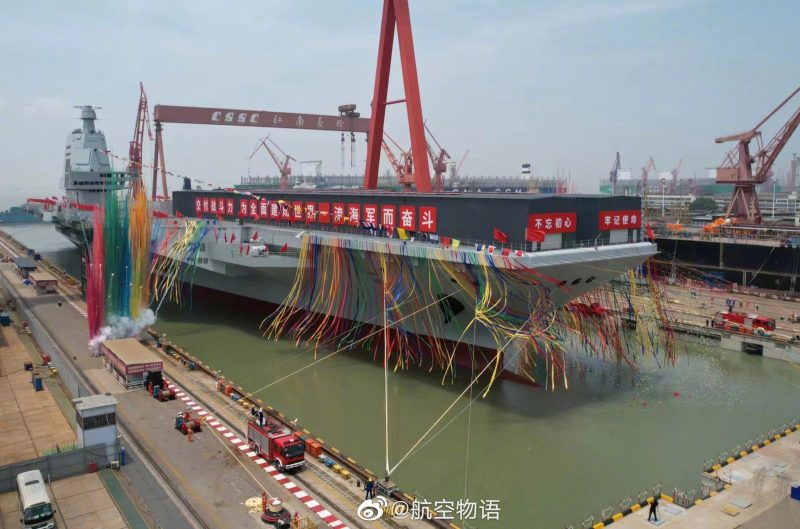China’s third aircraft carrier, hailed by state media as “the mightiest warship” ever built by an Asian nation, is also the first to rival US aircraft carriers in size and capabilities.
The vessel, which is China’s first locally-designed and made carrier, has a full-load displacement of more than 80,000 tonnes, comparable to Nimitz and Ford class carriers built by the US.
It is also a high-tech carrier, the first Chinese-built one to use EMALS – Electro-Magnetic Aircraft Launch Systems (or catapults) – and arresting devices for the launch and landing of jets on its deck. The new carrier, named after the coastal province of Fujian, is expected to carry the J-35, China’s latest fighter jet.
The vessel underscores the big strides made by China to close the gap on US naval power as the world’s two biggest economies jostle for ascendancy. Paris-based Naval News says the carrier catapults China’s navy into the 21st century and that it’s the first non-US carrier in the world ”to even come close” to US carriers.
“The US Navy still has a massive lead,” it said. “But China will take the second spot in terms of numbers and size. It faces competition though. Britain has revived its once-pioneering capability, and France is building a newer carrier in the same league as the Chinese ones.”
China Outpaces US Tenfold on Hypersonic Missiles: US General
‘Mightiest Warship’
The China Daily hailed the Fujian, built at China State Shipbuilding Corp’s Jiangnan Shipyard in Shanghai and launched today, as “the mightiest warship that any Asian nation has ever built.”
“The carrier was towed out of its dry dock as color stripes were fired along the dock to celebrate the moment,” the paper reported.
China launched its first aircraft carrier, The Liaoning, in 2012 and that was based on a former Soviet hulk sold to China as scrap. Its second carrier, the Shandong, launched three years ago, was an improved version of the same Soviet design, with a ‘ski jump’ ramp at the front of the flight deck.
In his book ‘The Long Game’, American scholar Rush Doshi said China’s leaders were so daunted by the US’s military capabilities in the first Gulf War in 1991 that they preferred to build up their economy by securing ‘most favoured nation’ trade status, and adhering to Deng Xiaoping’s advice to “hide and bide” their ambition to return to great power status – until the Global Financial Crisis in 2008 led them to believe they were narrowing the gap with the world’s superpower.
“After the Global Financial Crisis, China began to emphasize building regional order. It no longer felt the need to constrain itself for fear of rattling Washington or the wider region,” Doshi wrote.
That strategic shift led to the building of dozens of advanced warships and destroyers, plus major investments in transport craft and amphibious infantry, he said, as well as volunteering for anti-piracy patrols in the Gulf and talks on its first overseas naval base in Djibouti in early 2014.
Now, he said, the country is eyeing further naval bases in Myanmar (Kyauk Phyu, in the Bay of Bengal), Gwadar (Pakistan), the Seychelles, Sri Lanka (Hambantota), Tanzania (Dar Es Salaam) and Cambodia (Ream naval base).
• Jim Pollard with Reuters
ALSO on AF:
US Suspects North Korea Tested Ballistic Missile System
Russia’s Ukraine Hypersonic Missile Claim Misses The Mark
























